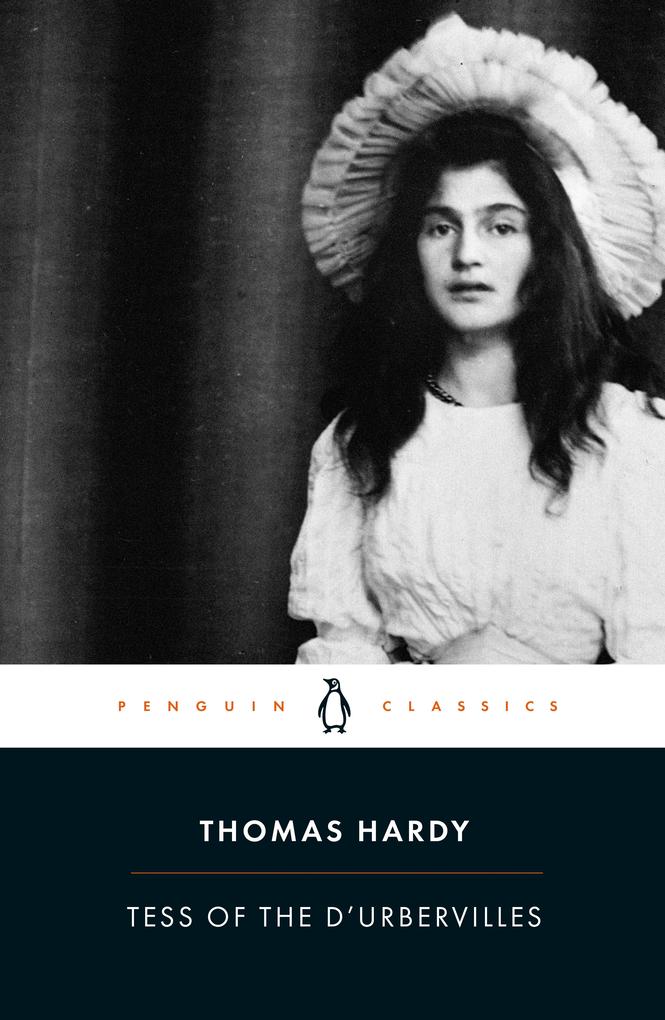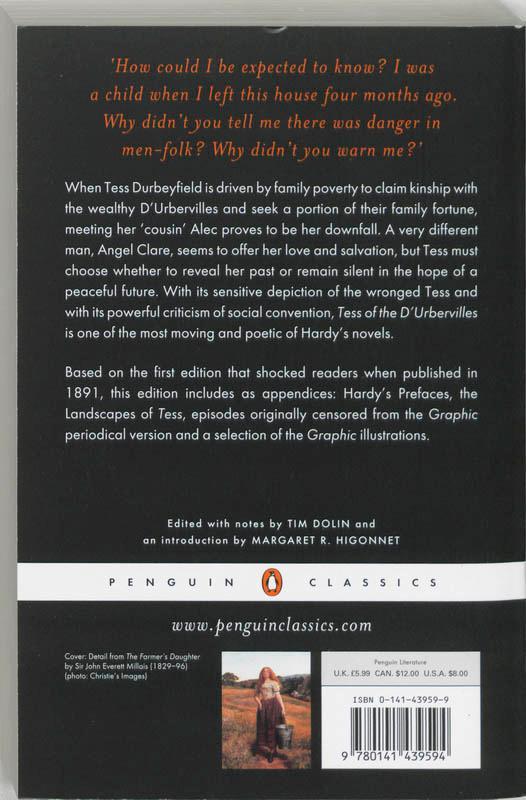
Zustellung: Sa, 16.11. - Di, 19.11.
Sofort lieferbar
VersandkostenfreiBestellen & in Filiale abholen:
A heartbreaking portrayal of a woman faced by an impossible choice in the pursuit of happiness
When Tess Durbeyfield is driven by family poverty to claim kinship with the wealthy D'Urbervilles and seek a portion of their family fortune, meeting her 'cousin' Alec proves to be her downfall. A very different man, Angel Clare, seems to offer her love and salvation, but Tess must choose whether to reveal her past or remain silent in the hope of a peaceful future. With its sensitive depiction of the wronged Tess and powerful criticism of social convention, Tess of the D'Urbervilles, subtitled "A Pure Woman," is one of the most moving and poetic of Hardy's novels.
Based on the three-volume first edition that shocked readers when first published in 1891, this edition includes as appendices: Hardy's Prefaces, the Landscapes of Tess, episodes originally censored from the Graphic periodical version, and a selection of the Graphic illustrations.
For more than seventy years, Penguin has been the leading publisher of classic literature in the English-speaking world. With more than 1,700 titles, Penguin Classics represents a global bookshelf of the best works throughout history and across genres and disciplines. Readers trust the series to provide authoritative texts enhanced by introductions and notes by distinguished scholars and contemporary authors, as well as up-to-date translations by award-winning translators.
When Tess Durbeyfield is driven by family poverty to claim kinship with the wealthy D'Urbervilles and seek a portion of their family fortune, meeting her 'cousin' Alec proves to be her downfall. A very different man, Angel Clare, seems to offer her love and salvation, but Tess must choose whether to reveal her past or remain silent in the hope of a peaceful future. With its sensitive depiction of the wronged Tess and powerful criticism of social convention, Tess of the D'Urbervilles, subtitled "A Pure Woman," is one of the most moving and poetic of Hardy's novels.
Based on the three-volume first edition that shocked readers when first published in 1891, this edition includes as appendices: Hardy's Prefaces, the Landscapes of Tess, episodes originally censored from the Graphic periodical version, and a selection of the Graphic illustrations.
For more than seventy years, Penguin has been the leading publisher of classic literature in the English-speaking world. With more than 1,700 titles, Penguin Classics represents a global bookshelf of the best works throughout history and across genres and disciplines. Readers trust the series to provide authoritative texts enhanced by introductions and notes by distinguished scholars and contemporary authors, as well as up-to-date translations by award-winning translators.
Mehr aus dieser Reihe
Produktdetails
Erscheinungsdatum
30. Januar 2003
Sprache
englisch
Seitenanzahl
LXVIII
Reihe
Dover Thrift Editions: Classic Novels
Autor/Autorin
Thomas Hardy
Herausgegeben von
Tim Dolin
Verlag/Hersteller
Originalsprache
englisch
Produktart
kartoniert
Gewicht
402 g
Größe (L/B/H)
198/128/26 mm
ISBN
9780141439594
Entdecken Sie mehr
Pressestimmen
[Tess of the D Urbervilles is] Hardy s finest, most complex and most notorious novel . . . The novel is not a mere plea for compassion for the eternal victim, though that is the banner it flies. It also involves a profound questioning of contemporary morality. from the Introduction by Patricia Ingham
Bewertungen
LovelyBooks-Bewertung am 13.04.2020
Tess ist die älteste Tochter der armen Familie Durbeyfield. Als der Vater erfährt, dass sie angeblich dem alten Adelsgeschlecht der D'Urbervilles entstammen, soll Tess Bekanntschaft mit der Familie gleichen Namens machen und möglichst dort einheiraten. Tess' Begegnung mit Alec D'Urberville wird aber auf tragische Weise den weiteren Verlauf ihres Lebens bestimmen."Tess of the D'Urbervilles" ist der bekannteste Roman des englischen Autors Thomas Hardy (1840 - 1928), dessen Markenzeichen eine unglaublich atmosphärische und lebendige Darstellung des bäuerlichen Lebens und der Natur darstellt. Hardy beschreibt die Landschaft seiner Heimat Dorset, in seinen Büchern das fiktive "Wessex". In Tess beschreibt er gekonnt den Zusammenprall der bisherigen Handarbeit auf den Feldern mit der beginnenden Maschinisierung der Landwirtschaft. Hardys Respekt vor den einfachen, hart arbeitenden Menschen und seine Liebe zur Landschaft seiner Heimat stechen aus jeder Seite hervor, was mich zu einem großen Fan dieses Autors macht. Natürlich wird nichts romantisiert, was die Handlung von "Tess" sehr deutlich macht.Mit zunehmendem Alter griff der Autor für die damalige Zeit kontroverse Themen auf, bis sein letzter Roman "Jude the Obscure" einen solchen "Shitstorm" hervorrief, dass Hardy sich fortan nur noch der Poesie widmete. Das aber nur zur Erläuterung. In "Tess" wird die Protagonistin vergewaltigt und wird dadurch schwanger. Daran und an den Konsequenzen wird sie sich stets schuldig fühlen. Um der Zensur zu entgehen wird die Szene äußerst vage beschrieben, der Fokus liegt aber auch eindeutig auf den Folgen. Im ganzen Buch wird deutlich, dass Hardy seine männlichen Mitmenschen kritisiert, die ein "Nein" einer Frau einfach nicht akzeptieren können und die überhaupt die Meinung einer Frau missachten.So stellt Alec D'Urberville Tess permanent nach und zerstört letztlich ihre Beziehung zu einem anderen Mann, Angel Clare. Hier gehe ich aber nicht weiter in die Tiefe, sonst ist das keine Rezension mehr. ¿Fazit:Trotz des düsteren Themas konnte mich "Tess of the D'Urbervilles" durch eine Protagonistin fesseln, die stets versucht, ihre Selbstbestimmung und ihren Stolz zu wahren. Daneben entschädigen die wunderschönen Beschreibungen der Natur und des bäuerlichen Lebens für die Tragik des Romans.
LovelyBooks-Bewertung am 07.04.2020
Tragisches vom großen Meister



































